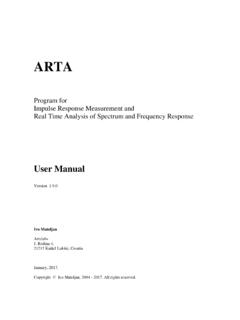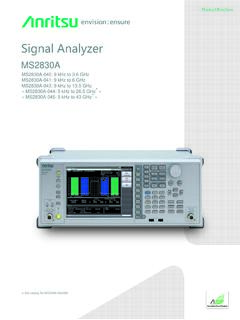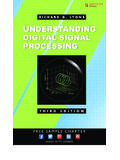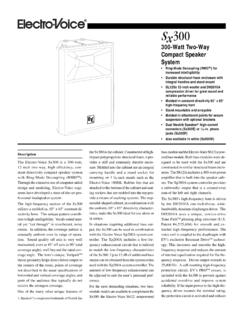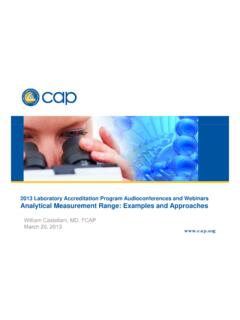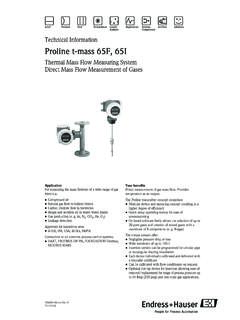Transcription of Detection and Measurement of Radar Signals: A Tutorial
1 Detection and Measurement of Radar Signals: A Tutorial 7th Annual ISART Frank H. Sanders NTIA Institute for Telecommunication Sciences 1 March 2005 OUTLINE 1. Radar EMISSION FUNDAMENTALS a) Pulse duty cycles b) Transmitter peak power levels c) Antenna gain d) US Radar spectrum bands 2. Radar PARAMETERS a) Radar spectrum engineering criteria (RSEC) b) Waveform (pulse) width, rise time, fall time, modulation c) Pulse repetition rate d) Antenna patterns e) Emission spectra a. Measurement hardware and algorithms b. Measurement dependence on bandwidth c. Do spectra have to be measured in the far field? 2 Radar EMISSION FUNDAMENTALS -Emissions are pulsed. Usually about duty cycle (typically 1 us pulse width, and 1 ms pulse repetition interval). -Peak transmitter power levels often around 1 MW.
2 -Antenna gain often around 30 dBi. -Peak EIRP levels around 1 GW. Mission Pulse width (us) Pulse rate (Hz) Peak power (MW) An-tenna gain (dBi) PeakEIRP (GW) Short range air search 1 1000 33 Long range air search 3-10 300 1 33 2 Maritime navigation 10000 30 Weather 1-5 300-1300 45 24 3 MAJOR US Radar SPECTRUM BANDS 5-25 MHz HF OTH-B functions 420-450 MHz space search, airborne search 902-928 MHz air search 1215-1400 MHz long range air search 2700-2900 MHz air traffic control (terminals)
3 2900-3100 MHz air & marine search, weather 3100-3700 MHz air search 5250-5925 MHz air search, weather GHz airborne functions GHz airborne functions GHz airborne functions GHz low power ( , police radars) 4 Radar PARAMETERS Radar Spectrum Engineering Criteria (RSEC) - Established by NTIA, adhered to by all US Federal Government radars. - Is the basis for other Radar emission standards, both internationally and domestically (for example, MIL-STD 494 - Specifies, for radars, limits on spurious and out-of-band emissions (collectively called unwanted emissions). - Specifies additional requirements for Radar performance of factors such as antenna patterns, receiver selectivity, and receiver LO emissions.)
4 - Does NOT guarantee that no interference will occur!! - Requires that many Radar emission parameters need to be measured so that emission masks can be drawn. 5- Does not explain how to do the measurements See NTIA Reports and ITU-R Recommendation for such explanations. 6 RSEC Compliance Measurements Require: -Pulse width and rise time (or fall time) Measurement ; -Pulse repetition rate Measurement (although this requirement may disappear soon) - Radar transmitter peak power Measurement ; - Radar antenna pattern Measurement ; - Radar emission spectrum Measurement . 7 WAVEFORM PARAMETER MEASUREMENTS Figure 1. Schematic diagram of RSEC pulse shape parameters. Note that the nominal flat top level may have to be estimated as a best-fit on the detected envelope. 8 Figure 2. Block diagram schematic for measuring waveform parameters using a directional coupler.
5 9 Figure 3. Block diagram schematic for measuring radiated waveform. 10 Example Measurement Data Figure 4. Diagram of RSEC parameters for a weather Radar pulse. 11 Figure 5. Diagram of RSEC parameters for a short-range search Radar pulse. 12 Figure 6. Diagram of RSEC parameters for a phase-coded pulse with three chips. 13 Figure 7. Measurement of the frequency deviation in time of a frequency -modulated pulse. 142. PULSE REPETITION RATE Example Measurement Data repetition rate = 1096 secpulse repetition interval = mSTime (milliseconds)Amplitude (detected volts) Figure 8. Example of a fixed-PRR Radar pulse sequence. 15 Figure 9. Pulse repetition Measurement on a single channel of a frequency -hopping Radar made with a spectrum analyzer in a zero-Hertz span mode and positive peak Detection .
6 The line is an estimated threshold for on- frequency pulses. 16 (msec)Amplitude (detected volts) Figure 10. The pulse repetition rate of the same Radar as that shown in Figure 9, but measured with a broadband detector configured as in Figure 3. 175. EMISSION SPECTRA Table 1. Determination of RSEC Measurement Bandwidth (Bm) Radar Modulation Type RSEC Measurement Bandwidth (Bm): Non-FM pulsed and phase-coded pulsed Bm (1/t), where t = emitted pulse duration (50% voltage) or phase-chip (sub-pulse) duration (50% voltage). Example for non-FM pulsed: If emitted pulse duration is 1 s, then Bm 1 MHz. Example for phase-coded pulsed: If Radar transmits 26- s duration pulses, each pulse consisting of 13 phase-coded chips that are each 2 s in duration, then Bm 500 kHz. FM-pulsed (chirped) Bm (Bc/t)1/2, where Bc = frequency sweep range during each pulse and t = emitted pulse duration (50% voltage).
7 Example: If Radar sweeps (chirps) across frequency range of MHz during each pulse, and if the pulse duration is 55 s, then Bm 154 kHz. CW Bm = 1 kHz; See sub-paragraph of [1, Chapter 5] for RSEC Criteria B, C and D. Example: Bm = 1 kHz. FM/CW Bm = 1 kHz; See sub-paragraph of [1, Chapter 5] for RSEC Criteria B, C and D. Example: Bm = 1 kHz Phase-coded CW Bm (1/t), where t = emitted phase-chip duration (50% voltage). Example for phase-coded pulsed: If chip duration is 2 s, then Bm 500 kHz. Multi-mode radars Calculations should be made for each waveform type as described above, and the minimum resulting value of Bm should be used for the emission spectrum Measurement .
8 Example: A multi-mode Radar produces a mixture of pulse modulations as used in the above examples for non-FM pulsed and FM-pulsed. These values are 1 MHz and 154 kHz, respectively. Then Bm 154 kHz. 18 -70-60-50-40-30-20-100102030405001020304 01 kHz3 kHz10 kHz30 kHz100 kHz300 kHz1 MHz3 MHzArbitrary UnitsReceived Power in Indicated Bandwidth (dBm) Figure 11. Example of a bandwidth progression Measurement for assessment of the proper bandwidth in which to measure a Radar spectrum for RSEC compliance. 19 -90-80-70-60-50-40-30-20-100102700275028 0028502900300 kHz100 kHzFrequency (MHz)Measured Power Level in Specified Bandwidth (dBm) Figure 12. Emission spectrum Measurement performed on a multi-mode chirped Radar . 20 Figure 13. An example of a spectrum Measurement error caused by an incorrect RF attenuation setting.
9 21 Figure 14. Example spectrum of an air search Radar . 22 Figure 15. Example bandwidth progression Measurement of the fundamental for the Radar having the measured emission spectra of Figure 16. 23 Figure 16. Three spectra for a single Radar for which the bandwidth progression is shown in Figure 15. 244. ANTENNA PATTERNS . Figure 17. Example Radar antenna pattern for a surface search Radar . 25 Figure 18. Three antenna patterns (top) & median of patterns (bottom). 26 APPENDIX A: DEFINITIONS Spectrum Regions Table A-1. Definitions of Spectrum Regions and Related Terms, from Chapter 6 of [1] Term Definition Necessary bandwidth For a given class of emission, the width of the frequency band which is just sufficient to ensure the transmission of information at the rate and with the quality required under specified conditions.
10 Necessary bandwidths for radars as a function of emission type are provided in Annex J of [1]. Out-of-band emissions Emission on a frequency or frequencies immediately outside the necessary bandwidth which results from the modulation process, but excluding spurious emission. Spurious emissions Emission on a frequency or frequencies which are outside the necessary bandwidth and the level of which may be reduced without affecting the corresponding transmission of information. Spurious emissions include harmonic emissions, parasitic emissions, intermodulation products and frequency conversion products, but exclude out-of-band emissions. Unwanted emissions These consist of spurious emissions and out-of-band emissions. 27 APPENDIX B: ENSURING ADEQUATE Measurement SYSTEM INPUT ATTENUATION FOR RSEC MEASUREMENTS Hardline Coupling to a Radar Transmitter For hardline-coupled measurements, some attenuation will likely be required between the directional coupler output and the Measurement device input (see Figure 1).



